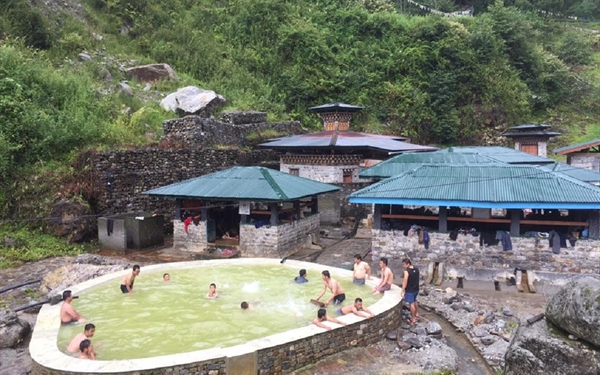The popularity of hot springs and hot stone baths in Bhutan
In Bhutan, hot springs and hot stone baths play significant roles in Bhutanese lives.
In Bhutan, when you fall ill, aside from visiting the hospital or health care centres, the next best thing you can do is to either soak in a tsachu or dip into a menchu. These traditional healing practices dating back to the 7th century. And interestingly, Bhutan has an ancient name 'Menjung', the land of medicinal herbs.
Hot springs which are popularly known as tsachus in Bhutan, are well-known for their medicinal properties. The hot springs are usually found in volcanically active areas. For centuries, the locals believe that medicinal water will cure different kinds of ailments and diseases such as arthritis, chronic headaches, skin diseases or tuberculosis. Aside from the health benefits, the locals will also travel to the hot springs for relaxation. Some of these hot springs provide the most picturesque landscapes for you to enjoy while you heal your body.
The popular tradition amongst the Bhutanese is to visit hot springs during the winter season. The locals will spend at least 3 days to weeks dipping in the spring water. In the olden days, people had to hire ponies or mules to reach the hot springs due to the inaccessibility of the roads. Today, with the improved road conditions, one can easily visit a tsachu at any time. Bhutanese will visit the tsachu at least once a year with their family or friends.
Some of the most popular hot springs in Bhutan are Gasa Hot Spring, Duenmang Tsachhu in Zhemgang District , Gelephu Tsachu , Koma Tsachu & Chuboog Tsachu in Punakha.
Among all the tsachus in Bhutan, Gasa Tsachu is rated as the most popular tsachu for foreigners followed by Duenmang Tsachu. These two tthanksa sachus are popularly visited by tourists who embark on the Gasa-Laya Trek or Snowman Trek.
Chubu Tsachu
Driving three hours on the feeder road past Punakha town along the banks of the Pho Chu River is home to Chubu Hot Spring blessed by Guru Padmasambhava. The tshachu is not widely known to Bhutanese. However, like Gasa Hot Spring, there are many miracle anecdotes shared from Chubu Hot Spring. The Tshachu has two ponds and it is believed that the water in the first pond can cure dermal diseases, tuberculosis, and stomach ailments.
Despite the Covid-19 pandemic, hundreds of locals are found rushing to the Chubu Hot Spring to heal from various illness and defilements.
The best season to visit hot springs in Bhutan
Spring and Autumn season from Feb, March, April, May are the best times to visit hot springs in Bhutan. It is believed that during spring when the tree roots sprout, it will add medicinal value to the water thus creating rich mineral value to the hot spring.
Menchu (Hot Stone Baths) in Bhutan
Aside from the hot springs, you can also opt to soak in a menchu (hot stone bath). The traditional hot stone bath is an alternative therapy to the hot springs. The stone baths are available in some five-star properties but you can also find some in more rustic settings and traditional farmhouses.
The process begins with heating large river stones on firewood until it turns iron red. The red stones are then dipped into the water in the wooden tub. The temperature of the water can be increased by adding more heated stones into a wooden chamber. The chamber is connected to the main tub which contains the water for soaking. The holes in the chamber allow the heat to be infused into the bath and are said to release minerals into the water that are believed to have medicinal properties. Sometimes, herbs are also added to provide the fragrance.
You can visit a hot stone bath in Bhutan all year round. However, it is advisable to make arrangements with your tour operator to make a prior booking.
While hot springs in Bhutan are free, a hot stone bath experience in Bhutan can cost anywhere from Nu. 1000 (approx. USD14) to Nu. 3000 (approx. USD40).






